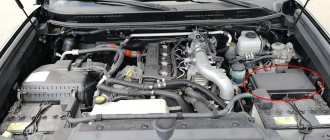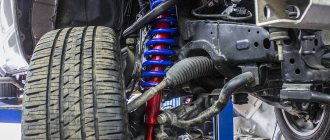The voluminous and powerful 5VZ-FE engine from Toyota Corporation is a special development for SUVs. The company has made every effort to ensure that the crown of the VZ series remains in the memory of car lovers and connoisseurs of large-capacity engines. The unit began to be produced in 1995 and was discontinued only in 2004. All this time, the engine was manufactured without any special changes in the technical base, and was also installed on many cars from both Toyota and other manufacturers.
The technologies are quite simple. This is a cast iron cylinder block, aluminum head, maintainable design and reliable parts. Toyota's recipe for success is simple - the company collected all the best from engines already existing at that time and created an excellent engine with optimal parameters. Please note that this is an atmospheric internal combustion engine; the turbines here can only be foreign ones. We'll talk about this below in the section on tuning.
Technical specifications and important data about the 5VZ-FE
It is worth noting that modifications were carried out several times during production, but they did not affect the main characteristics of the motor. We added VVT-i, removed some childhood diseases, and redesigned the control system. But in general, even the early versions from 1995-1999 perform their tasks very well.
The main parameters of 5VZ-FE are as follows:
| Working volume | 3.4 l |
| Cylinder block | cast iron |
| Number of cylinders | 6 |
| Number of valves | 24 |
| Cylinder arrangement | V-shaped |
| Fuel injection system | injector |
| Rated power | 190 hp at 4800 rpm |
| Max. torque | 298 N*m at 3600 rpm |
| Unit weight | 190 kg |
| Fuel | 95 |
| Fuel consumption: | |
| — urban cycle | 16 l / 100 km |
| - suburban cycle | 11 l / 100 km |
| Timing system drive | belt |
| Gearboxes | 5 manual transmission, 4 automatic transmission, 5 automatic transmission (Toyota only) |
Fuel consumption depends on the vehicle on which the engine is installed.
Also, the atmospheric nature of the unit and several types of installed boxes greatly influence this indicator. For example, with a 4-speed automatic in the city on a Prado, consumption will reach 20 liters per hundred or more. On a manual, the same car can achieve 13-14 liters. When reviewing the characteristics, you can see that the unit grabs well from the bottom. But the main advantages are noticeable precisely at high speeds. Two camshafts, a good oil cooler and a modified cooling system of the unit made it better than most representatives of the VZ line.
Reliability, problems and repair of the Toyota 5VZ-FE engine
The next engine for Toyota off-road models appeared in 1995 and was developed on the basis of the 3VZ-E. The V6 cylinder block with 60° camber was taken from 3VZE, but the cylinders were increased in diameter from 87.5 mm to 93.5 mm, and new pistons were placed in them with a compression ratio of 9.6. This made it possible to achieve a working volume of 3.4 liters.
Instead of single-shaft cylinder heads, the 5VZ used more modern heads with two camshafts. They are similar to those used on 3VZ-FE, but with some changes. The camshafts on the 5VZ are lower than on the 3-liter predecessor. The timing belt was also replaced with a different one. An oil cooler was used on the 5VZ, and the cooling system fan was also modified. The intake manifold was made longer than on the 3VZ to improve low speed performance, and the ACIS variable length system was not used. The exhaust manifold has been optimized, the ignition system has also changed slightly and phased fuel injection has been used (as on the 1MZ). The changes described above made it possible to optimize the engine for SUVs, pickups and commercial vehicles. For the 5VZ-FE, TRD produced compressor kits that made it possible to increase the power of these engines to 245 hp and torque to 360 Nm. Production of the 5VZ was discontinued in 2004, and the engine compartment of Toyota SUVs was tightly occupied by the more recent 1GR-FE.
Problems and disadvantages of Toyota 5VZ engines
The main problems of the 3.4-liter engine are the same as those of the 3-liter 3VZ, but the problem with the cylinder head gasket is less pronounced and the engine itself is somewhat more reliable. You can read more about this here. In addition to Toyota, this engine was used on GAZ Volga cars, and it is also a popular option for swapping into other Russian cars (UAZ Bukhanka, Bars, GAZ Gazelle and others).
What advantages does the 5VZ-FE motor offer?
According to the owners, this engine has only advantages. And the main benefits are hidden in the simplicity of the design. If you are an experienced auto mechanic, DIY repairs and maintenance will not pose any problems. The manufacturer put a lot of effort into the development and got a decent result.
Here are just some of the advantages that can be seen in the operation of the unit:
- Power and good volume. You can go fast, but to do this you need to turn the engine. At low speeds you feel a good reserve under the pedal.
- Boxes. Toyota installed only its own gearboxes for this model; all had low-range gears and other privileges for SUVs.
- Successful generator. Most versions have an 80A generator, which is enough for the comfortable operation of all equipment without any problems.
- The cooling system is perfectly refined. The Japanese have created a unique system that maintains the ideal operating temperature even when operating a heavy SUV in off-road conditions in constant downshifts.
- Work on gas. The engine is not demanding on fuel; it can be easily converted to liquefied gas and get significant savings in your refueling budget.
You can often read in reviews that the DOHC system was a bad solution for this unit. But in practice it shows itself perfectly. Perhaps in 1995 it was a new product for craftsmen, and it was not easy to maintain. Today this is the simplest system that can be installed in any prepared garage. So there are practically no problems with the simplicity and reliability of the design.
Does the classic Japanese V6 have serious problems?
This unit also has its drawbacks, even if they are minor. Let us note right away that the resource of 5VZ-FE is estimated by experts at 350,000 km. These are approximate data, but they are puzzling. You'd expect millions of miles from a big V6 from Japan, but in this case you'll have to prepare for an overhaul. The cylinder block, pistons, flywheel, and valves are subject to wear.
Also during operation, owners encounter the following problems:
- the starter has to be regularly changed or rebuilt; its design turned out to be not the most successful;
- it is difficult to replace the mass air flow sensor, as well as to diagnose the breakdown of this sensor due to the specifics of the installation;
- rollers in the timing system - even the original ones often do not last as long as they should, so they have to be changed more often;
- throttle valve - the unit often becomes clogged due to the use of poorly purified gasoline;
- spark plugs - surprisingly, spark plugs are replaced quite often; original parts are needed.
In general, spare parts are a headache for many owners of cars with this engine. It’s not difficult to find used components, but their quality turns out to be quite low. And the prices for new spare parts are not just high, they are often exorbitant. When repairing, an inexperienced technician may have problems. The operating order of the cylinders is 1, 2, 3, 4, 5, 6. If you mix up the wire connections when replacing spark plugs, you will have to repair the cylinder head. So you should read the manual before doing any repairs or maintenance yourself.
What cars were the 5VZ-FE unit installed on?
- Toyota Land Cruiser Prado (1995-2004).
- Toyota Tundra (2000-2004).
- Toyota Tacoma (1995-2004).
- Toyota T-100 (1995-1998).
- Toyota 4Runner (1996-2002).
- Toyota Granvia (1995-2002).
- GAZ 3111 (2000-2004).
Toyota Land Cruiser Prado 120 2008. Mileage 38,000 km. Time capsule.
Toyota Dubrovka Technical Center welcomes you, dear readers. Some time ago we discussed the 2004 Toyota Land Cruiser Prado 120, which was imported from Europe. Its mileage has now surpassed 500,000 km. Another feature of this SUV is its diesel engine and atypical equipment for Russia. In addition, the technical condition of the SUV itself can give odds to many copies.
New or with minimal mileage Toyota Land Cruiser Prado 120? This can only happen in a fairy tale or Japan, or maybe in another country. Quite a lot of time has passed since 2009 and it is quite difficult to find a really good car with a clear history and low mileage. Of course, such cars with low mileage do occur. For example, our technical center services two 120 Pradikas, the mileage of which does not exceed 80,000 km. As a rule, this is the second or third car in the family. Such SUVs are used as needed occasionally on weekends. Because for commuting to work there is either a company car, a taxi, metro or even car sharing.
We got a little distracted. And so a 2008 Toyota Land Cruiser Prado 120 with a mileage of 38,000 km came to us for maintenance! This event caused a certain resonance - in fact, a time capsule. It was very interesting to once again find myself in the interior of a car, where it still smells like a new car. The driver's seat is not worn out and has no cracks or creases on the side. Everything under the hood is pristine. The engine compartment has never been washed. Yes, it is dusty, but that can be fixed. The history of this SUV is typical - it was purchased new in 2008 and is used extremely rarely. This car is in the maximum configuration, which was available for order in Russia.
As the years go by, the car ages and loses value. This phrase cannot be applied to the Toyota Land Cruiser Prado 120. The cost of such cars, contrary to the laws of economics, does not decrease. A car in this condition will be sold within a couple of minutes - no doubt, and at the maximum market price. Most of these cars have covered hundreds of thousands of kilometers long ago and you shouldn’t believe that you will get a car with a clear history and a low mileage of 150,000 km. Check carefully, especially for legal purity. Of course, the safety margin provided by the manufacturer is enormous. This is especially true for the chassis. But you shouldn’t buy such an SUV, especially without diagnostics!
And we will return to our time capsule. Such rare use has affected the leather interior - the upholstery requires rubbing with cream - conditioner. There is also a lot of dust in the cabin. The windshield is not worn or replaced.
The 4-liter petrol V6 simply “whispers”. It's just a little dusty. Over the years of inactivity, the drive belt of the attachment has “dried out” and it is advisable to replace it. The spark plugs have not been changed - the replacement schedule is 100,000 km. The body is in factory paint, no accidents. The factory boots between the body and frame are not torn, all the pistons are in place.
Of course, there is corrosion, since the car was still used. First of all, the rear axle. The exhaust system on a car that is practically not used suffers in the same way - this can be seen in the photograph. Otherwise everything is fine. Don’t forget that this Toyota Land Cruiser Prado 120 was operated in the Moscow region, where anti-ice agents are poured onto the roads in winter.
Let's get back to the chassis. It’s nice to see units that don’t leak oil. The transfer case is especially pleasing to the eye. On many cars it has strong oil stains due to a leaking actuator seal. Brake fluid is hygroscopic, meaning it absorbs moisture. On this car it was dark in color - most likely it had never been changed. The same applies to oils in gearboxes. Therefore, if you rarely use your car, do not forget about annual maintenance. That is, maintenance (TO) is performed not by mileage, but by time interval.
In addition to changing oils and brake fluid, we performed preventive maintenance on the brake system. The caliper brackets were cleaned and lubricated.
Don't forget about filters. We replaced the engine air filter and cabin filter. After the maintenance, a comprehensive wash of this Toyota Land Cruiser Prado 120 was planned as a pleasant gift for the owner. It would also be possible to take high-quality photographs on the street with proper lighting... But these plans did not come true - the owner of this time capsule arrived earlier than the appointed time... Another time.
Swap and expanded use of the engine in Russia
For swaps, not only contract engines from Japan are purchased. Preference is often given to Russian used options that ended up being dismantled. It’s better to choose a good contract engine with low mileage and provide the necessary resource. The price of such an engine starts at 80,000 rubles, and the cost of a model in perfect condition is close to 100,000 rubles.
Swap has some features:
- It’s best to immediately buy a complete set for installation with attachments, wiring and the original ECU;
- take into account the environmental class at the Euro-3 level if you are going to do certification or legalization;
- It is better to install power plants that have not been disassembled; even the wrong tightening torque of the cylinder head can kill the purchase in 2-3 thousand km;
- installation is possible only on cars with a large engine compartment, otherwise all the filling will not fit;
- Pay special attention to the wiring diagram for electrical parts and sensors; you will need a manual for this.
They install the 5VZ-FE engine with significant modifications on the Volga, UAZ Patriot, UAZ Bukhanka or Hunter. Craftsmen also install such engines on Gazelle. There are proposals for installing this model of power unit on minibuses, such as Renault Master. But there is no good feedback database for analyzing such alterations.
Tuning - how to increase the power of a naturally aspirated six?
There are both complex and artisanal tuning options. You can buy a turbocharger kit from TRD and install it yourself. The power in this case will be about 250-260 horsepower. Replacing pistons with options from older engines can increase the engine potential to 300 horses.
They also increase power by installing a more efficient exhaust system and performing alternative ECU pinouts.
The branded Superscharger kit is another option for significantly changing the technical characteristics of the engine in your car. It’s worth reading American forums, where this particular tuning option is used most often.
Toyota 5VZ-FE engine tuning
5VZ Compressor
Having such an engine, going into it with sports shafts, trying to remake the intake and exhaust, etc., is not a very reasonable thing to do, and it’s also terribly expensive. For this engine, you can buy a compressor kit from TRD, based on the Eaton M62 compressor. A new one costs quite a lot, but used ones can be found for reasonable money. It is better to use injectors from 2JZ-GE. At a pressure of 0.5 bar, with stock pistons, you will get about 250-260 hp. and a significant increase in torque throughout the entire range. By replacing the pulley with a 56 mm (2.2″), you will increase the boost to 0.6 bar and get about 280 hp. on 98 gasoline. By installing a sports exhaust without catalysts, you will add about 10 more hp. You can buy a 2.1″ (or even 2″) pulley, thereby increasing the pressure to 0.75 bar and getting more than 300 hp, but you need to reduce the compression ratio or install water-methanol injection.
ENGINE RATING: 4
<<BACK
Conclusions - main information about the Toyota 5VZ-FE engine
The engine turned out to be quite successful. Its large volume and the absence of complex systems and technologies make it possible to operate the unit quite adequately in any conditions. It is well suited to off-road vehicles, spins well and offers flexible operation. Also, the power plant is suitable for those who want to increase power to the maximum.
But there are also disadvantages to the 5VZ-FE. This is high fuel consumption, lack of efficient turbines and other advantages in stock trim levels. They also note a rather weak resource, as for this type of units. However, many copies reach 500,000 km without significant repairs. It all depends on the quality of operation and maintenance of the engine.











